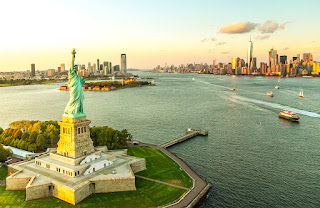
The term “New York Bay” refers to both Upper New Bay and Lower New York Bay, which are linked by the Narrows. Upper New York Bay, which includes the Port of New York and New Jersey, is also known as New York Harbor. Lower New York Bay merges with the Atlantic Ocean. The Narrows, a narrow strait between Brooklyn and Staten Island, connects the two bays.
Giovanni da Verrazzano, commissioned by King Francis I of France, is the first European to discover the Bay in 1524. In honor of the King, who was also Count of Angoulême, he named it “New Angoulême.”
The Hudson River and the Gowanus Canal feed Upper New York Bay.
Upper New York Bay is home to several well-known islands, including Liberty Island, Ellis Island, and Governor’s Island.
Two artificial islands can be found a mile from Staten Island’s South Beach in Lower New York Bay. Hoffman Island, which was established in 1873, and Swinburne Island, which was originally known as Dix Island, are two examples.
A large reef along the New Jersey side of Upper New York Bay once held one of the world’s largest oyster beds, but pollution destroyed it by the end of the 1800s.
There are numerous lighthouses in Lower New York Bay, both on the water and on land. The first lighthouse, known as the Sandy Hook Light, was built during colonial times.
A wide range of marine species can be found in Upper New York Bay. Bluefish and striped bass are two examples.
Some parts of Upper New York Bay are popular for recreational sailing and kayaking.







